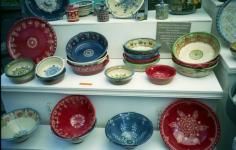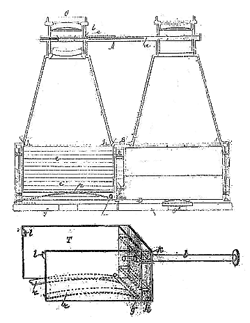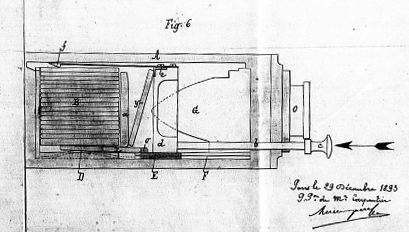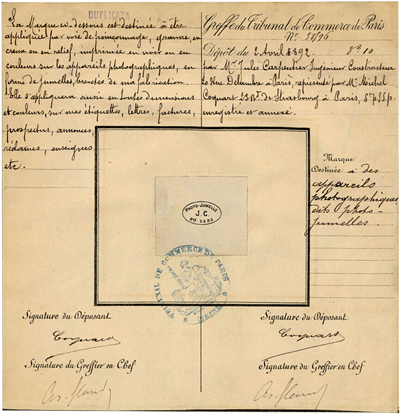|
Carpentier Photo-Jumelle |
Manufactured or assembled in France from 1890 to (After) 1890.
Index of rarity in France: Rare (among non-specialized garage sales)
Inventory number: 16052
See the complete technical specifications
Chronology of cameras Carpentier
Jules Carpentier took over Ruhmkorff's workshop (who had worked with Charles Chevalier before opening his own workshop in 1855).
A precision equipment manufacturer, especially of electrical devices, he was the first to build a mass-produced camera with interchangeable parts. Interestingly, despite the undeniable success he achieved in this field, he only built one type of camera.
It was Carpentier whom the Lumière brothers entrusted with the mass production of their first motion picture camera.
If Carpentier only manufactured one type of camera, the Jumelle type, he diversified it into numerous models.
|
||
|
||
|
||
|
||
|

Carpentier's Jumelle is a pioneering camera because they are small in size and easy to use. The viewfinder is at eye level, which has the advantage, as Carpentier puts it, of having the same perspective between what is seen and what is photographed.
Although it appears as a camera with two lenses, only one of the two lenses is used for capturing images, while the other serves as the front part of the viewfinder. The whole camera resembles a viewer, and there is a strong temptation to place one's eyes in front of the lenses, which resemble the eyepieces of a pair of binoculars.
The magazine for the plates is integrated into the camera.
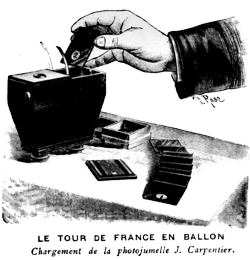
Depending on the model of Photo-Jumelle, it can accommodate 12 or 18 plates. In the early models, these plates measure 4.5 x 6, which is small compared to what is obtained with contemporary cameras. Photo-Jumelle come in various negative formats, with a wide range of lenses. Therefore, there are many models.
Here are a few:
| Size | Plates | Lens | |||
| Photo-Jumelle | 6.5 x 9 | 12 | Zeiss Krauss Protar 8/110 mm | Focusing |
|
| Photo-Jumelle | 4.5 x 6 | 12 | |||
| Photo-Jumelle | 4.5 x 6 | 12 | |||
| Photo-Jumelle | 6.5 x 9 | 18 | Zeiss Krauss 8/110 mm | ||
| Photo-Jumelle | 6.5 x 9 | 18 | Krauss Quatryl 4.5/10.5 cm | Focusing | |
The Photo-Jumelle, having been very successful, led to a large number of accessories and improvements.
| REFILLING IN BRIGHT LIGHT AND ON-THE-GO FOR MAGAZINE CAMERAS AND ESPECIALLY THE CARPENTIER PHOTO-JUMELLE BY MR. F.-M. RICHARD. Presentation made to the Société Française de Photographie during the session of December 7, 1894 (1) During transfer to the photo-jumelle, frame No. 11 falls to the bottom of the photo-jumelle, followed by Nos. 10 to 1. At this point, with 11 frames in the photo-jumelle, pull the drawer rod, move the frames into the viewer compartment. Then transfer the last frame (No. 12) into the photo-jumelle and, by pushing back the drawer, the 11 frames move on top. Frame No. 12 is thus correctly positioned last at the bottom. So, one needs as many loaders as desired, plus one empty one, to have as many dozens of plates available. |
Dr. Hocquart used a Carpentier Jumelle during the Madagascar expedition, bringing it additional renown. Magazines echoed this, showing engravings executed from photos taken during the expedition... photo reproduction in magazines was not then commonplace!
Gervais Coutellemont also used it to photograph the holy city of Mecca.
(from Gallica/BNF/INPI) __________
This first model of the J. Carpentier Jumelle type camera has a built-in 12 plates 4.5 x 6 store (No. 4582-21). The lens is unbranded. The diaphragm is fixed, and the guillotine shutter has only one speed. The right lens serves as a viewfinder. The winding is done by pulling to the side and reveals a part of the mechanism.
Plate changing is done by pulling on a button.

Interesting links or bibliography :
Add a link or element of bibliography, a picture taken with this camera, a picture of box or an ads about this camera
Your photos taken with the same camera:
Cameras from Ebay France (Carpentier) (Uploaded each 3 hours)






